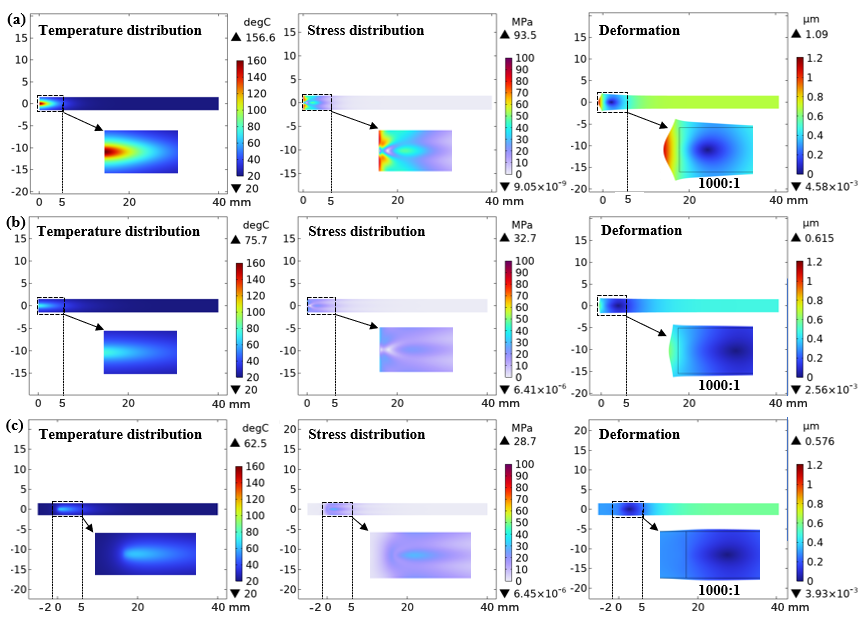2025-05-13 中国科学院(CAS)

Temperature, stress, and strain distributions in the axial cross section of gradient-doped crystals. (a) 0.39 ~ 0.80 at.% crystal; (b) 0.17 ~ 0.38 at.% crystal; (c) 0 at.% + 0.17 ~ 0.38 at.% crystal. (Image by MA Tianyu)
<関連情報>
- https://english.cas.cn/newsroom/research_news/phys/202505/t20250514_1043649.shtml
- https://www.sciencedirect.com/science/article/abs/pii/S0030399225005882
- https://www.sciencedirect.com/science/article/abs/pii/S1350449525001380
勾配ドーパント濃度を最適化し熱効果を改善した高性能電気光学Qスイッチ2kHzネオジム:YAGレーザー High-performance electro-optically Q-switched 2-kHz Nd:YAG laser with optimized gradient dopant concentration and thermal effects improvement
Shengjie Ma, Zhengdong Xiong, Li Wang, Renqin Dou, Qingli Zhang, Meng’en Wei, Tingqing Cheng, Haihe Jiang
Optics & Laser Technology Available online: 19 April 2025
DOI:https://doi.org/10.1016/j.optlastec.2025.112997
Abstract
The thermal effects of the gain medium impose significant constraints on achieving high-power high-beam-quality lasers. Gradient-doped crystals can effectively mitigate thermal effects. We use self-grown gradient-doped crystals, and adopt a combination of multiple strategies including diffusion-bonded end caps, pump beam size optimization, and thermal effects compensation, to mitigate the thermal effects of the crystals under the high-power operation. A high-brightness, high-conversion-efficiency, and high-stability laser output is achieved, with an average power up to 12 W at a repetition rate of 2 kHz using a bonded gradient-doped (0 at.% + 0.17–0.38 at.%) Nd:YAG crystal, which corresponds to a peak power of 882 kW. The beam quality is M2x=1.240 and M2y=1.251, and the power instability is 0.31 % (RMS). To the best of our knowledge, this is the highest peak power achieved under near-diffraction-limited conditions for an end-pumped single-rod Nd:YAG laser, with a brightness reaching 5.02 × 1013 W/(cm2·Sr).
エンドポンプグラジエントドープNd:YAG結晶の熱効果とその抑制 Thermal effects and their suppression of end-pumped gradient-doped Nd:YAG crystals
Shengjie Ma, Zhengdong Xiong, Ziran Liu, Li Wang, Renqin Dou, Qingli Zhang, Meng’en Wei, Tingqing Cheng, Haihe Jiang
Infrared Physics & Technology Available online: 3 April 2025
DOI:https://doi.org/10.1016/j.infrared.2025.105845
Highlights
- Gradient-doped crystals co-optimize thermal effects and conversion efficiency.
- Gradient-doped crystals exhibit superior laser performance.
- Numerical simulation guides novel gradient-doped crystal optimization and growth.
Abstract
In this study, a gradient-doped crystal with low thermal effects and low dopant concentration is designed. A numerical analysis model for gradient-doped crystals is established to analyze the impact of dopant concentration on their temperature field and stress–strain field, providing a theoretical basis for optimizing the concentration distribution and growth of novel gradient-doped crystals. The laser characteristics of the optimized gradient-doped (0 at.% + 0.17–0.38 at.%) Nd:YAG crystal are verified through both theoretical analysis and experiments. It is demonstrated that this design not only further smooth and homogenize the longitudinal pump absorption distribution, effectively mitigating thermal effects under high-power operation, but also significantly enhance the output performance. When the continuous pump power of the 808 nm laser diode was increased up to 110 W, a favorable output power growth trend was maintained, achieving a maximum output power of 49.7 W. The maximum optical-to-optical conversion efficiency reached 51.9 %, with a maximum slope efficiency of 57.4 %. This study provides a guidance for further optimization of the concentration distribution of gradient-doped crystals and end-pumped laser technology.



